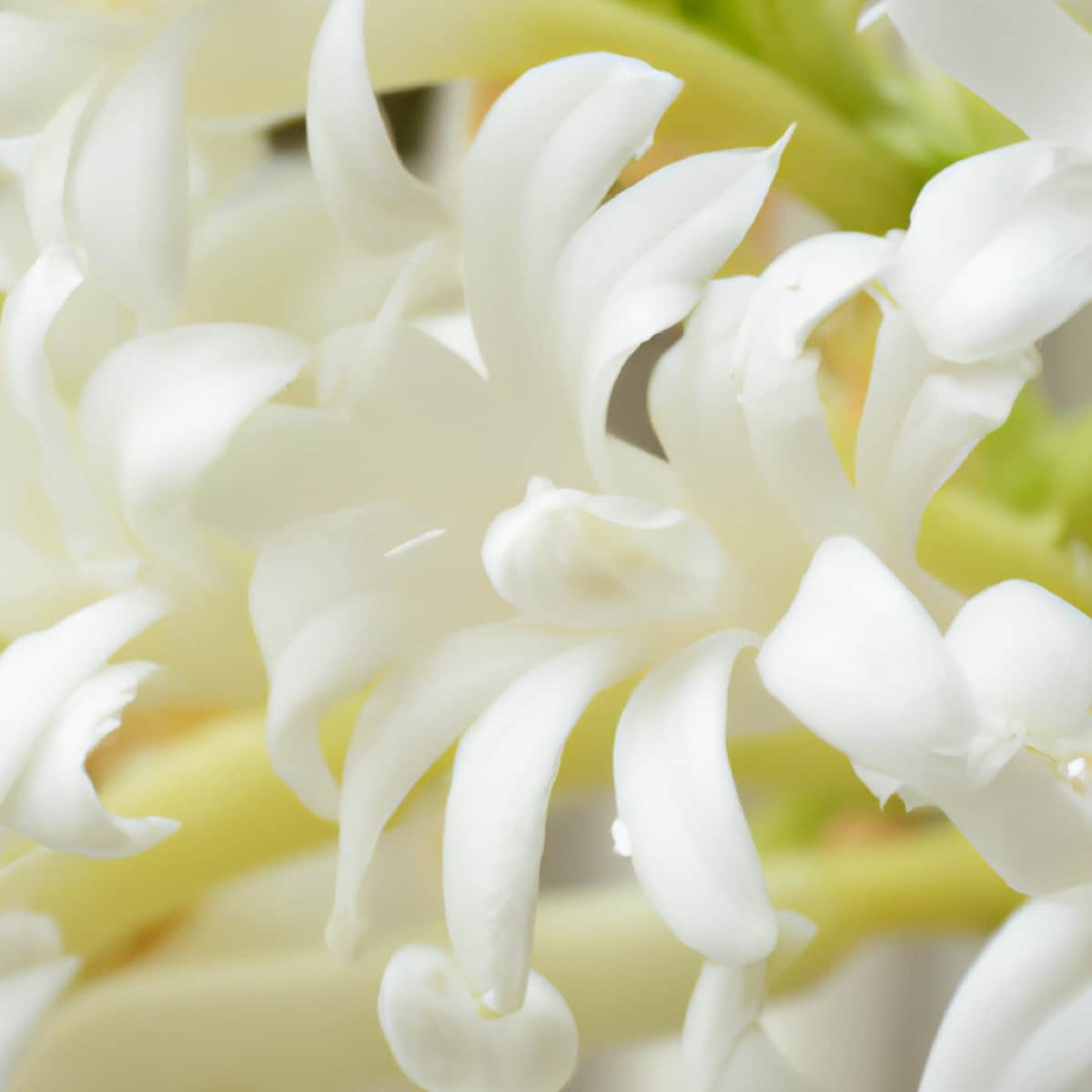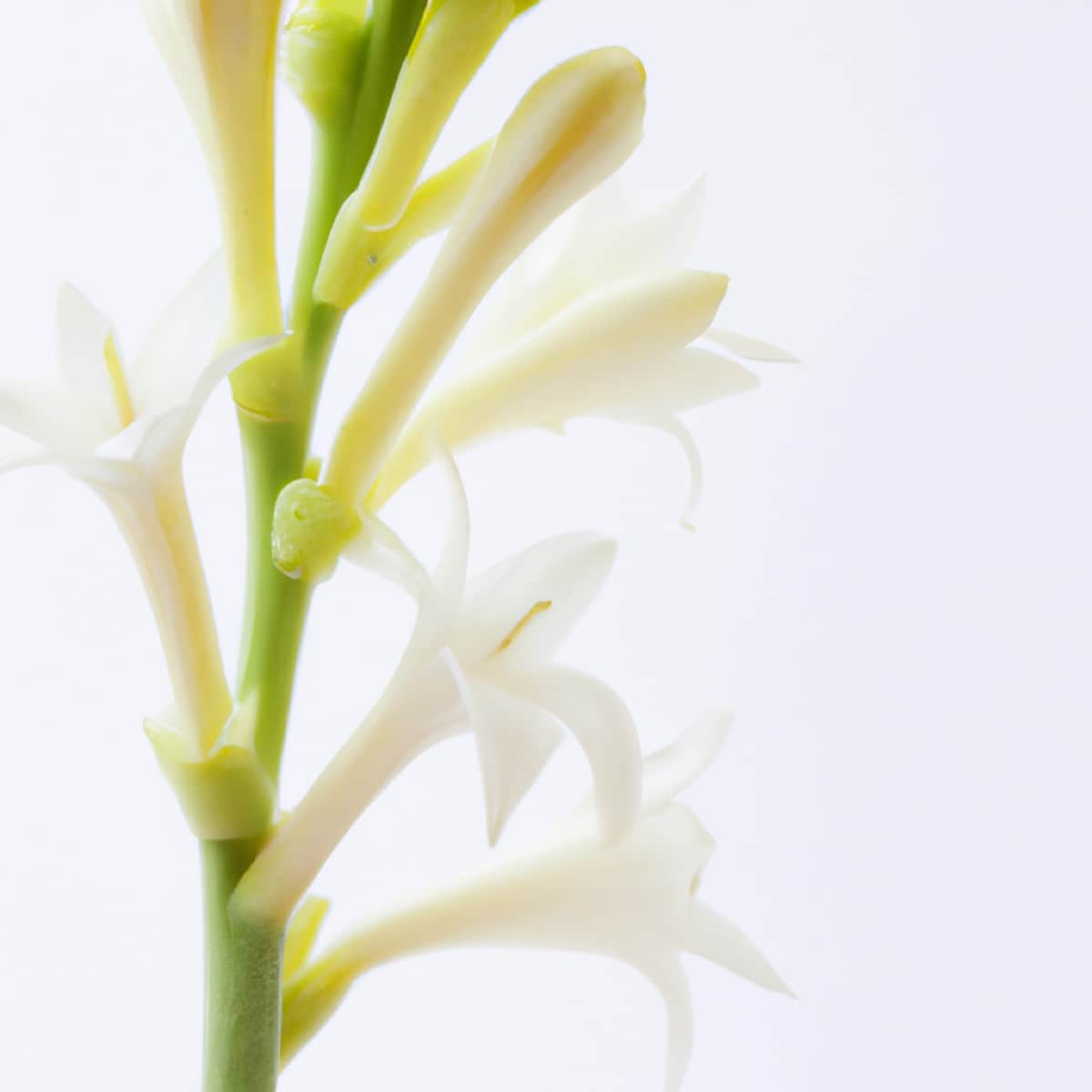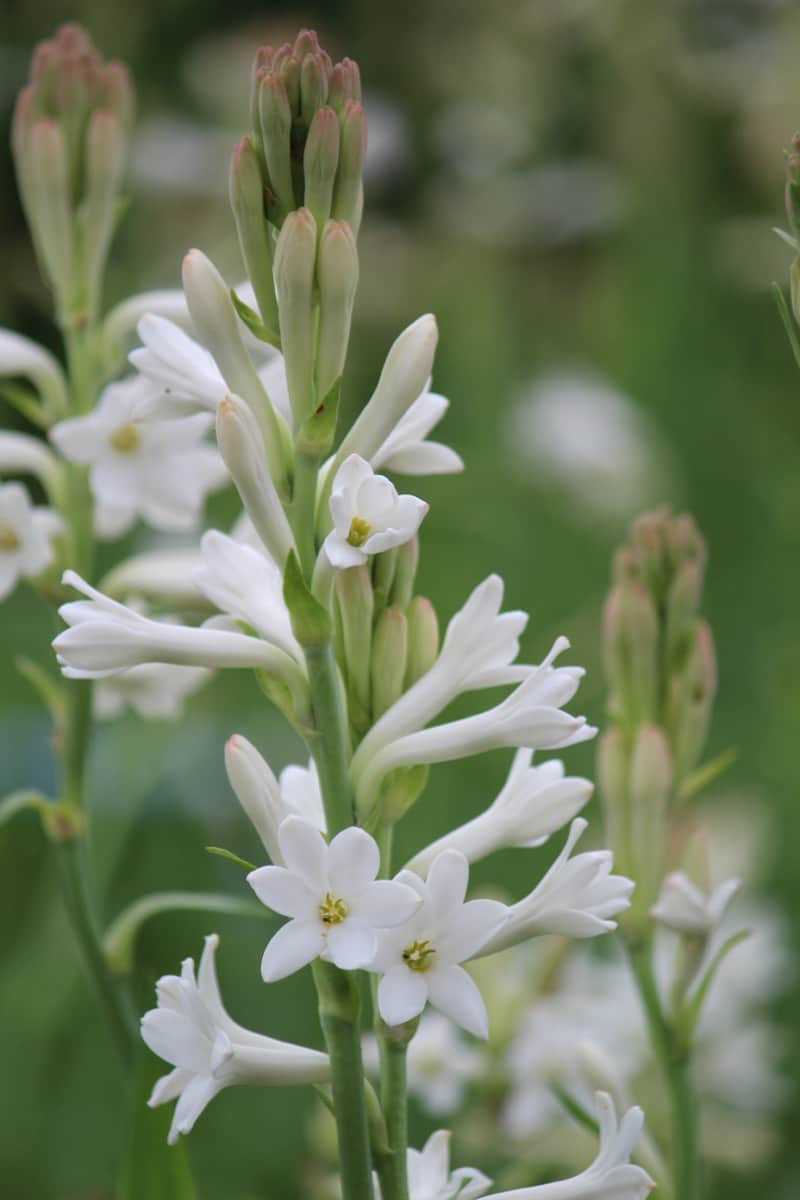Welcome to our blog on Common Tuberose plant pests and control! This article will explore the causal organisms, damage symptoms, spread, treatment options, prevention strategies, and management techniques for these pests. Join us as we enlighten you on protecting your tuberose plants and ensuring a healthy yield. Let’s learn!

How to Treat Tuberose Pests
Tuberose is a perennial flowering plant in the Agavaceae family, native to Mexico. Tuberose is a bulbous plant characterized by its underground storage organ called a bulb, which allows it to survive adverse conditions and regrows each year. It features long, slender stems with lanceolate leaves, producing clusters of white, waxy, tubular flowers with a prominent fragrance.
The tuberose plant is highly valued for its captivating fragrance and elegant appearance. With its distinct aroma and ornamental appeal, the tuberose plant has gained popularity in gardens, floral arrangements, and perfume production. It requires specific growing conditions to thrive, making it a fascinating plant for botanists, gardeners, and horticulturists.
Ten Major and Common Pests of Tuberose
- Bud Borer Pest: Causes damage by making tunnels or holes in buds, leading to wilting, discoloration, or drooping of buds.
- Aphids Pest: Feed on the sap of tuberose plants excreting sticky honeydew, resulting in curling, distortion, and yellowing of leaves.
- Red Spider Mite Pest: Causes stippling, yellow spots, and leaf webbing due to feeding on lower leaf surfaces.
- Grasshoppers Pest: Causes irregular holes, ragged leaf edges, and partially eaten flowers by chewing on leaves, stems, and flowers.
- Weevils Pest: Weevils are beetles that feed on foliage and cause irregular notches or holes in the leaves and flower buds.
- Whiteflies Pest: Causes white, powdery excrement on lower leaf surfaces, causing yellowing and wilting of leaves, stunted growth, and reduced flowering.
- Tuberose Beetles Pest: They feed on the leaves, flowers, and stems of plants, causing irregular holes, skeletonization, defoliation, and reduced flower production.
- Tuberose Scale Pest: They form waxy, protective covers and attach themselves to the leaves, stems, and bulbs, causing yellowing, wilting, and stunted growth.
- Mealybugs Pest: They form white, cottony masses on the plant, causing distorted, curled leaves and stunted growth.
- Tuberose Bulb Flies Pest: Their larvae feed on the bulbs, causing rotting, decay, soft spots, discoloration, and foul odor.
Bud Borer Pest Control in Tuberose
- Causal Organism: Helicoverpa armigera
- Symptoms: They bore into and create entry holes and tunnels within the flower buds. Infested plants may show greenish larvae, frass excrement, wilting, discoloration, drooping, and premature bud dropping.
- Favorable Conditions: They prefer warm and moist conditions of 20-30 °C, weeds, and dense plantings for feeding, reproduction, and survival.
- Treatment: Spray pyrethroids, carbamates, or Bt-based insecticides. Practice crop rotation and sanitation. Use pheromone traps to monitor and capture adult bud borer moths.
Aphids Pest Control in Tuberose
- Causal Organism: Aphis craccivora
- Symptoms: They feed on the plant sap and excrete a sticky, sugary substance called honeydew. The honeydew serves as a medium for the growth of black sooty mold. Infested plants show curling, chlorosis, wilting, and deformed flowers.
- Favorable Conditions: They prefer warm and humid weather of 20-25 °C, tender, succulent plant tissues, nitrogen-rich soils, stressed plants, and crowded plantations.
- Treatment: Spray insecticidal soaps, neem oil, bifenthrin, cypermethrin, and imidacloprid. Practice pruning, companion planting, spacing, sanitation, regular monitoring, and weeding.
Red Spider Mite Pest Control in Tuberose
- Causal Organism: Tetranychus urticae
- Symptoms: They suck the sap from tuberose leaves, and their webs serve as protective shelters. Infested leaves show yellowing, bronzing, webbing, stippling, curling, and premature leaf drop.
- Favorable Conditions: They prefer warm, arid, and dry climatic conditions of 21-32 °C, dense plantings, low air circulation, and monoculture.
- Treatment: Spray insecticidal soaps, bifenazate, and neem oil. Practice crop rotation, regular monitoring, pruning, sanitation, spacing, and companion planting. Release predatory mites, ladybugs, or lacewings to control the pest.
Grasshopper Pest Control in Tuberose
- Causal Organism: Atractomorpha renulata
- Symptoms: They feed on the leaves, stems, and flowers and cause chewing damage. Infested plants defoliation, stunted growth, flower damage, wilting, yellowing, and overall decline.
- Favorable Conditions: They prefer warm and arid 25-35 °C environments, dense vegetation, and weeds for egg laying and hatching.
- Treatment: Practice crop rotation, tillage, mixed cropping, weeding, and monitoring the plants regularly. Use natural predators like birds, spiders, predatory insects, and nematode species, such as Steinernema spp.
Weevil Pest Control in Tuberose
- Causal Organism: Myllocerus spp.
- Symptoms: The characteristic damage is that they chew irregular holes or notches in the leaves, resulting in a ragged appearance. Infested plants show deformed, discolored flowers, feeding scars on the plant’s surface, and wilting, yellowing, or stunted growth.
- Favorable Conditions: They prefer warm and moist soils of 20-30 °C, vegetative growth stage, and high-density planting for reproduction and survival.
- Treatment and Management: Practice sanitation, crop rotation, monitoring the plants regularly, and using yellow sticky traps, pheromone traps, and physical barriers.
In case you missed it: How to Identify and Treat Maize Diseases: Symptoms, Spread, and Control Management

Whiteflies Pest Control in Tuberose
- Causal Organism: Bemisia tabaci
- Symptoms: The distinctive symptom is the excretion of honeydew due to feeding on plant sap. Infested plants show growth of sooty mold, leaf chlorosis, curling, reduced flower production, and stunted growth.
- Favorable Conditions: They prefer warm and humid environments of 20-30 °C and 60-90% humidity, stressed plants, weeds, and crop debris.
- Treatment and Management: Spray imidacloprid or thiamethoxam. Practice pruning, sanitation, spacing, and maintaining plant nutrition. Use yellow sticky traps.
Tuberose Beetles Pest Control in Tuberose
- Causal Organism: Eutrichapion puberulum
- Symptoms: The characteristic symptom is the skeletonization of the leaves due to feeding, giving a skeletonized or lacy appearance. Infested plants show ragged leaf edges, defoliation, and deformed flowers.
- Favorable Conditions: They prefer warm environments of 20-25 °C, dense plantings, low air circulation, stressed plants, weeds, and vegetative growth stage.
- Treatment and Management: Spray carbaryl, bifenthrin, cyfluthrin, or imidacloprid. Practice sanitation, crop rotation, monitoring, and use of physical barriers. Release natural predators such as ladybugs and lacewings.
Tuberose Scale Pest Control in Tuberose
- Causal Organism: Coccus hesperidum
- Symptoms: The characteristic symptom is the damage caused by feeding on sap. Infested plants show leaf chlorosis, wilting, honeydew, sooty mold, stunted growth, and reduced flower production.
- Favorable Conditions: They prefer warm and humid conditions of 24-29 °C and >60% humidity, poor airflow, stressed plants, and alternative hosts like weeds.
- Treatment and Management: Spray bifenthrin, permethrin, or deltamethrin. Practice pruning, sanitation, crop rotation, monitoring, and maintaining proper nutrient levels. Release natural predators, such as ladybugs, lacewings, and parasitic wasps.
Mealybugs Pest Control in Tuberose
- Causal Organism: Phenacoccus solenopsis
- Symptoms: The characteristic feature is the presence of waxy, white, cottony masses on the foliage. Infested plants show honeydew, sooty mold, leaf curling, chlorosis, stunted growth, and deformed flowers.
- Favorable Conditions: They prefer warm and humid conditions of 25-35 °C and >60% humidity, overcrowding, and stressed plants for reproduction.
- Treatment and Management: Spray carbaryl, permethrin, or imidacloprid. Practice pruning, sanitation, regular monitoring, and nutrient balance. Use natural enemies, such as parasitic wasps (Leptomastix dactylopii) or ladybugs (Cryptolaemus montrouzieri).
Tuberose Bulb Fly Pest Control in Tuberose
- Causal Organism: Merodon equestris
- Symptoms: They primarily target the underground bulbs of the plant. The larvae burrow into the bulbs and feed on the inner tissues. Infested plants show bulb rot, stunted growth, leaf chlorosis, wilting, stunted growth, and death.
- Favorable Conditions: They prefer warm and moist 20-30 °C soils, high soil organic matter, and alternative hosts like weeds.
- Treatment and Management: Spray imidacloprid, thiamethoxam, carbaryl, bifenthrin, and cypermethrin. Practice sanitation, crop rotation, deep planting, and monitor the plants regularly. Use physical barriers.
In case you missed it: How to Manage Insect Pests in Rice/Paddy: Damage Symptoms, Prevention and Control

Conclusion
Some major pests affecting tuberose plants include borer, aphid, red spider mite, grasshopper, weevil, whitefly, beetle, scale, mealybug, and bulb fly pests. Various organisms cause these pests and exhibit specific symptoms, modes of spread, and management approaches.
- Beneficial Insects in Pest Management
- Natural Solutions for Pest Control in Flower Gardens
- Types of Fungicides Used in Agriculture
- Common Issues in the Fruit Development Stage of Pomegranate Farming
- Fruit Development Issues in Papaya: Easy Solutions and Treatment
- Soil-Borne Diseases and How to Protect Your Plants
- Practices to Prevent Disease Spread in the Garden
- From Wilted to Thriving: How to Treat Root Rot Naturally in Houseplants
- Natural Remedies to Cure Brown Spots on Fig Tree Leaves